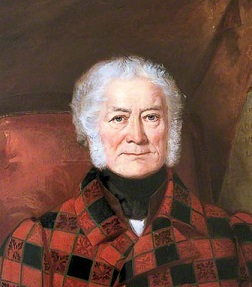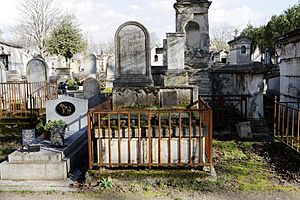John Gilchrist (linguist) facts for kids
Quick facts for kids
John Gilchrist
FRSE
|
|
|---|---|

Detail from portrait of Gilchrist by Blanconi, presented to UCL, 1866
|
|
| Born |
John Hay Gilchrist
19 June 1759 |
| Died | 8 January 1841 (aged 81) |
| Nationality | Scottish |
| Other names | John Borthwick Gilchrist |
| Alma mater | University of Edinburgh |
| Known for | Study of Hindustani Foundation of the Gilchrist Educational Trust |
| Scientific career | |
| Fields | Linguistics Lexicology Indology |
John Borthwick Gilchrist (19 June 1759 – 9 January 1841) was a Scottish surgeon and language expert. He was born and grew up in Edinburgh, Scotland. He spent many years in India, where he studied local languages.
Later in his life, he returned to Britain. He lived in Edinburgh and London. In his final years, he moved to Paris, France, where he passed away at 81.
Gilchrist is best known for his work on the Hindustani language. Because of him, it became a common language in northern India. This included areas that are now Pakistan. He wrote many important books. These included An English-Hindustani Dictionary and A Grammar of the Hindoostanee Language. He also helped start University College London. He created the Gilchrist Educational Trust, which helps people with education.
Biography
Early Life and Education
John Gilchrist was born on June 19, 1759, in Edinburgh. His mother, Henrietta Farquharson, lived to be 100 years old. Later in life, he added "Borthwick" to his name. This was his grandmother's family name.
He went to George Heriot's School and the Edinburgh High School. When he was 16, he traveled to the West Indies. There, he learned about growing indigo plants. He stayed there for a few years. Then he returned to Edinburgh.
Career in India
In 1782, Gilchrist became a surgeon's helper in the Royal Navy. He traveled to Bombay, India. He then joined the East India Company's Medical Service in 1784. As he traveled with the company's army, he noticed something important. People across India understood the Hindustani language.
He was surprised that the company did not encourage its staff to learn Hindustani. He believed that army officers needed to learn it. This would help them talk better with Indian soldiers.
Hindustani Dictionary
Gilchrist started to study Hindustani very carefully. He used this work to create his first dictionary. In 1787, he took a break from his medical duties. He spent 12 years living in different places in India. He traveled widely to work with native speakers. He also gathered materials for his books.
In 1786, he announced his first big book. It was called A Dictionary: English and Hindoostanee. It also had a grammar of the language. This book was special because it was the first printed in Devanagari type. This type was developed by Charles Wilkins.
About the Hindustani Language
The Hindustani language grew in Northern India. It helped new people from Persia and Turkey talk with locals. The local people spoke a dialect of Hindi languages. This dialect gave Hindustani its basic words and grammar. But it also took many words from Persian.
Gilchrist made Hindustani popular for British administration. When he first arrived, he was told that Persian was the main language. But he quickly found that few people spoke it well. He discovered that some in the East India Company already knew Hindustani. They called it "Moors language" or "Jargon." Gilchrist made it the new official language for British India.
Fort William College
Gilchrist suggested creating a training school for British recruits. This led to the founding of Fort William College in Calcutta in 1800. Gilchrist was the first leader of the college until 1804. He earned a very good salary. During this time, he published many more books.
Under Gilchrist, Fort William became a center for Urdu writing. The college taught a simple Urdu style. This was easy for British officers and traders to understand. One of Gilchrist's students was Henry Martyn. He helped translate the New Testament into Hindustani. By the early 1800s, Urdu slowly replaced Persian as the main language for government work.
In 1803, Gilchrist brought in other writers. They helped the Hindi language and literature grow quickly. The first Hindi newspaper, Udant Martand, was published in 1826.
Some experts debate Gilchrist's exact role. But he believed that Hindustani split into two languages: Hindi and Urdu. He is seen as a great supporter of Urdu. He also helped bring new life to Hindi. He encouraged a purer form of the language.
Land in Australia
In 1801, while in India, Gilchrist bought a large piece of land near Sydney, Australia. He never visited Australia. But as Sydney grew, the land became very valuable. This area is now part of the suburb called Balmain.
Return to Britain
In 1804, Gilchrist returned to Britain due to poor health. He never went back to India. He retired from the East India Company in 1805. He received a pension for the rest of his life.
He later moved to Edinburgh. He started a banking business, which eventually failed. He also became a member of important societies. People described him as a bit unusual. He had a strong temper and spoke his mind.
In 1817, he moved to London. He became a lecturer in oriental languages for the East India Company. He also helped start University College London. He was its first Professor of Hindustani. He also worked to create the London Mechanics Institution, now Birkbeck College.
Marriage and Children
Gilchrist had several children while he was in India. Three of his daughters born in India returned to Britain with him. They were Henrietta, Elizabeth, and Violet.
After returning to Edinburgh, Gilchrist married Mary Ann Coventry in 1808. She was much younger than him. They did not have any children together.
Final Years, Death and Legacy
Gilchrist moved to Paris in 1831. He died there on January 9, 1841, at age 81. He was buried in the Père-Lachaise Cemetery.
His Will
Gilchrist left a large fortune. This included property and investments. In his will, he asked that his money be used for a charitable trust. He wanted the money to be used "for the benefit and advancement and propagation of education and learning in every part of the world."
Legal Battle
Some of Gilchrist's family members challenged his will. The case was very complicated. It lasted for many years. It even went to the highest court in Britain, the House of Lords. In 1858, the court finally decided that Gilchrist's will was valid. This was 17 years after he died. This case became an important legal example for future cases.
Gilchrist Educational Trust
Because the legal battle took so long, the value of Gilchrist's land in Australia grew a lot. His total fortune was very large. With this money, the Gilchrist Educational Trust finally started its work in 1865. To this day, the Trust provides money to people and groups for education.
Character and Political Views
Gilchrist had a strong personality. He often got into arguments. He liked to write letters and pamphlets to share his thoughts. He was sometimes described as angry or aggressive. But people in power usually treated him well. He became a very rich man.
In Edinburgh, he was known for his strong political ideas. He believed in republicanism. These views made him some enemies. This, along with his banking business failing, made him leave Edinburgh for good. He only returned for short visits to his mother.
There are no pictures of him when he was young. But as an old man, he was described as having white hair and whiskers. His face was active and expressive. People said he looked like a "royal Bengal tiger." He was proud of this comparison.
Published Works
- A Dictionary: English and Hindoostanee, Calcutta: Stuart and Cooper, 1787–90.
- A Grammar, of the Hindoostanee Language, or Part Third of Volume First, of a System of Hindoostanee Philology, Calcutta: Chronicle Press, 1796.
- The Anti-Jargonist; a short and familiar introduction to the Hindoostanee Language, with an extensive Vocabulary, Calcutta, 1800.
- Dialogues, English and Hindoostanee, calculated to promote the colloquial intercourse of Europeans, on the most useful and familiar subjects, with the natives of India, upon their arrival in that country, Calcutta, 1802(?). Second edition: Edinburgh, Manners and Miller et al., 1809. lxiii, 253 p.
- The Hindee Director, or Student's Introductor to the Hindoostanee Language; comprising the Practical outlines of the improved Orthoepy and Orthography, along with first and general Principles of its Grammar, Calcutta, 1802.
- The Hindee-Arabic Mirror; or improved Arabic practical tables of such Arabic words which are intimately connected with a due knowledge of the Hindoostanee language, Calcutta, 1802.
- The Hindee-Roman Orthoepigraphical Ultimatum, or a systematic descriptive view of the Oriental and Occidental visible sounds of fixed and practical principles for the Language of the East, Calcutta, 1804.
- British Indian Monitor; or, the Antijargonist, Stranger's Guide, Oriental Linguist, and Various Other Works, compressed into a series of portable volumes, on the Hindoostanee Language, improperly called Moors; with considerable information respecting Eastern tongues, manners, customs, &c., Edinburgh: Walker & Grieg, 1806–8.
- Parliamentary reform, on constitutional principles; or, British loyalty against continental royalty, the whole host of sacerdotal inquisitors in Europe, and every iniquitous judge, corrupt ruler, venal corporation, rotten borough, slavish editor, or Jacobitical toad-eater within the British Empire, Glasgow: W. Lang. 1815.
- The Orienti-Occidental Tuitionary Pioneer to Literary Pursuits, by the King's and Company's Officers of all Ranks, Capacities, and Departments, either as probationers at scholastic establishments, during the early periods of life, their outward voyage to the East, or while actually serving in British India...A Complete Regular Series of Fourteen Reports...earnestly recommending also the general Introduction, and efficient Culture immediately, of Practical Orientalism, simultaneously with Useful Occident Learning at all the Colleges, respectable Institutions, Schools, or Academies, in the United Kingdom,...a brief prospectus of the art of thinking made easy and attractive to Children, by the early and familiar union of theory with colloquial practice, on commensurate premises, in some appropriate examples, lists, &c. besides a Comprehensive Panglossal Diorama for a universal Language and Character...a perfectly new theory of Latin verbs, London: 1816.
- The Oriental Green Bag!! Or a Complete Sketch of Edwards Alter in the Royal Exchequer, Containing a full Account of the Battle with the Books between a Belle and a Dragon: by a radical admirer of the great Sir William Jones's civil, religious, and political creed, against whom information have recently been lodged for the Treasonable Offence and heinous crime of deep-rooted Hostility to Corruption and Despotism, in every Shape and Form; on the sacred oath of Peeping Tom at Coventry, London: J.B. Gilchrist, 1820.
- The Hindee-Roman Orthoepigraphical Ultimatum;or a systematic, descriminative view of Oriental and Occidental visible Sounds, on fixed and practical principles for acquiring the ... pronunciation of many Oriental languages; exemplified in one hundred popular anecdotes, ... and proverbs of the Hindoostanee story teller, London: 1820.
- The General East India Guide and Vade Mecum: for the public functionary, government officer, private agent, trader or foreign sojourner, in British India, and the adjacent parts of Asia immediately connected with the honourable East India Company, London: Kingsbury, Parbury and Allen, 1825.
- Dialogues, English and Hindoostanee; for illustrating the grammatical principles of the Strangers' East Indian Guide, and to promote the colloquial intercourse of Europeans on the most indispensable and familiar subjects with the Natives of India immediately upon their arrival in Hindoostan, London: Kingsley, Parbury, and Allen, 1826.
- A Practical Appeal to the Public, Through a Series of Letters, in Defence of the New System of Physic, London: Parbury, Allen, & Co. 1833.
- A Bold Epistolary Rhapsody Addressed to the Proprietors of East-India Stock in particular, and to every individual of the Welch, Scottish and English nations in general, London: Ridgway, 1833.
See also
- Hindustani language
- Gilchrist Educational Trust


